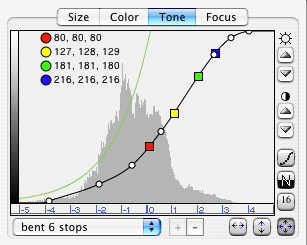
|
ViewFinder™ Software
TONE TAB PANEL – Contrast, Brightness and Bit Depth |
||||
|
Customize Your "Digital Film" Specs... The photographer has total control over every data bit — there are no “hidden” curves to clip data. The ViewFinder™ software features a precision processing curve editor for exact contrast and tonal gradation adjustments. All modifications are shown on the preview image to guide the photographer to the desired results. Unlike other digital camera technologies, the capture specificications are optimize BEFORE the final scan is made, resulting in the highest quality first-generation original image. Each processing curve determines the response of the digital camera from black to white, optimizing the image data for lighting conditions, subject matter, printer characteristics, or artistic expression. Contrast and tone adjustments are made on the original high bit-depth CCD data, retaining smooth gradations in the final image. Better Light digital cameras also support saving the file in high bit-depth data, without the application of any processing curve as a “raw” TIFF file. The file can also be saved in 16-bit color with the processing curve applied (16-bit button). These files are saved as a 16 bits per color (48-bit RGB data) and are twice the file size of the standard 8-bit TIFF. |
|
|||
|
||||
|
|
||||
